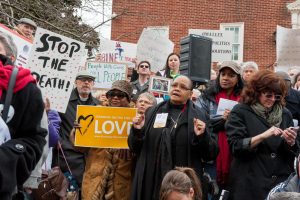Yes: History shows us that increased vigilance and stricter laws can make a difference against gun violence in America
June 24, 2023
Gun violence in America is a crisis. It permeates American society and haunts societal consciousness with every flash on screens with news of another shooting.
It’s sad, and frustrating and scary — how often can we see the same words pop up in the news before we disregard the status quo and take action? And what does taking action really mean for a problem so deeply entrenched in American society?
The dystopian truth is that we live in a society where news of mass destruction by single individuals isn’t just commonplace, it’s also seen as inevitable.
There is simply no one-track solution, a one-size-fits-all fix, to America’s biggest plague today: Guns.
So where does a solution lie and how do we find it?
Maybe figuring out why American society breeds so much gun violence, would be a good place to start.
Gun violence is disproportionately perpetuated by men. Caucasian men, to be exact. Analyses show that the better half of gun violence perpetrators have a history of domestic violence. The Stoneman Douglas High School shooter, for example, had a history of hurting animals and was receiving psychiatric attention for depression in the years leading up to the shooting.
The prevailing argument, supported by everything we’ve seen in the past, is that where there’s smoke, there’s fire.
Psychiatrist Amy Barnhorst writes of an incident with a patient who, after praising the Columbine shooters on Facebook and purchasing a gun, wasn’t involuntarily admitted to a mental hospital. After all, he exhibited no signs of violence or instability, just a concerning social media presence. Smoke was definitely rising in that case, but no further action was taken.
In a similar vein, when students are displaying signs of violence on social media or elsewhere, oftentimes, educators and fellow students ignore the signs. CNN cites signs as being anything from changes in behavior to “leakage,” which means when a possible gun violence perpetrator discusses their plan publicly. Most of the time, people aren’t aware of signs or how to counteract them, and so they go unreported. Solving this problem means stopping the amount of shooters who have historically been able to slip through the cracks undetected.
This is a microcosm of a larger trend: people that shouldn’t have access to guns are able to purchase them with incredible ease. In a perfect world, it wouldn’t be as easy as it presently is to get your hands on a gun.
In Australia and Great Britain, hard and fast laws popped up with incredibly quick turnaround following mass shootings during the 90s. Both nations adopted multimillion dollar gun-buyback programs and were met with success. One could argue that there’s too many external factors affecting statistical peaks and valleys in gun violence to trace their effectiveness, but the solitary truth prevails that laws do have positive effects on gun violence.
The logical solution to America’s gun problem would be stricter laws.
But not even California, the state with the strictest gun laws, and yes, the least gun violence in the country, is the safe-haven that one might expect. In 2023 alone, three shootings occurred in California with at least four victims.
Even though Californian gun laws are relatively unyielding, there are still multiple shortcomings; for instance, gun owners aren’t forced to relinquish weapons that were formerly legal but are now banned. California cannot remove guns from people who may have exhibited dangerous behavior, but aren’t properly flagged to courts or law enforcement. On top of all that, under-the-radar gun sales and what are colloquially known as “ghost guns” will always exist.
Even with all the might of state political power, there are holes in California’s safeguards against gun violence.
But the capacity for California to strengthen its laws, and thus, decrease gun violence across the state, is what separates it from the pack. Other U.S. states don’t share that luxury, and sadly, 2nd Amendment privileges make blanket laws across the country impossible.
America can never go the route of its British and Australian counterparts, but was it ever really going to? No other country has the same affliction, especially not at the same magnitude. The American fight against guns is unique, and thus is ours alone to combat.
It’s a frightening prospect that there is no perfect solution to the gun control crisis. It’s a terrifying world to live in, and an even more terrifying feeling to be helpless in the face of danger.
The argument most often posed in response to calls for stricter gun laws is that a determined shooter will get their hands on a gun regardless of legal safeguards in place.
Historically, this isn’t usually the case. Shooters usually purchase guns legally, sidestepping measures too flimsy to work as designed. Fewer and fewer people live to tell the tale.
There have been at least 163 mass shootings in America in 2023. The depth and gravitas of this problem doesn’t have to be spelled out, because it’s embedded in the headlines we read everyday, and litters the schools our youth are growing up in.
Parties can argue in circles, and philosophers can debate the ins-and-outs of gun control for centuries to come, but the answer will never be so simple.
No one solution is perfect, and none will guarantee the complete dissolution of guns in a culture so deeply enamored with them. But the more preventative measures in place and the more we treat signs with the weight they warrant, the better off we’ll be.




